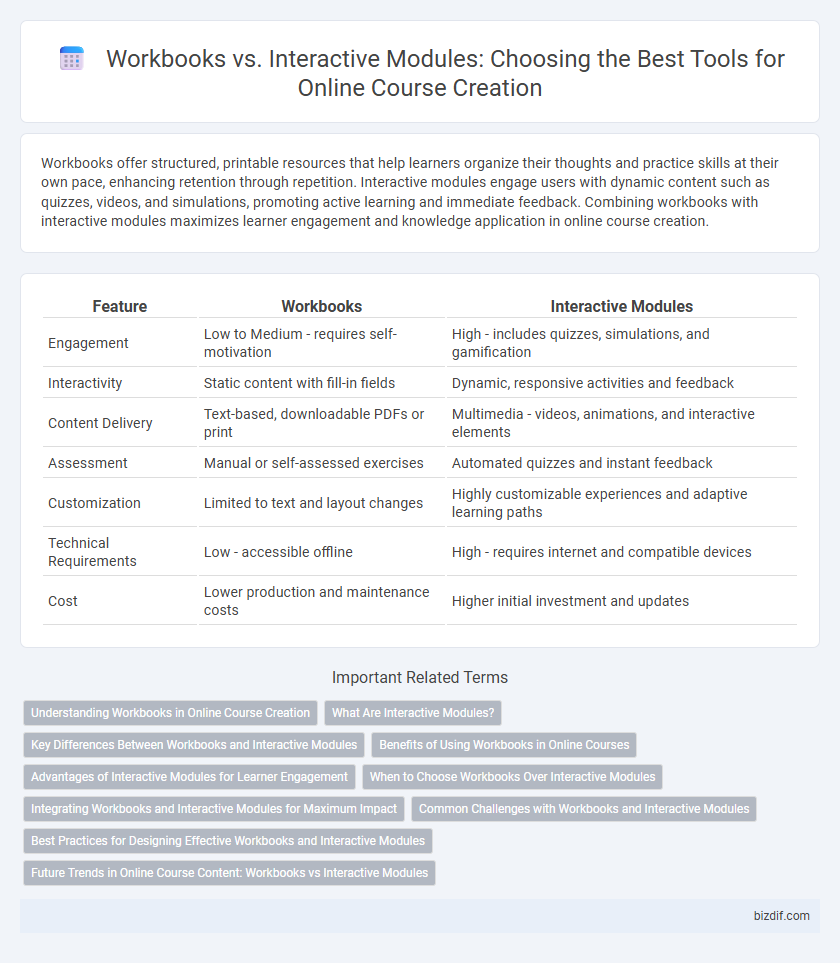Workbooks offer structured, printable resources that help learners organize their thoughts and practice skills at their own pace, enhancing retention through repetition. Interactive modules engage users with dynamic content such as quizzes, videos, and simulations, promoting active learning and immediate feedback. Combining workbooks with interactive modules maximizes learner engagement and knowledge application in online course creation.
Table of Comparison
| Feature | Workbooks | Interactive Modules |
|---|---|---|
| Engagement | Low to Medium - requires self-motivation | High - includes quizzes, simulations, and gamification |
| Interactivity | Static content with fill-in fields | Dynamic, responsive activities and feedback |
| Content Delivery | Text-based, downloadable PDFs or print | Multimedia - videos, animations, and interactive elements |
| Assessment | Manual or self-assessed exercises | Automated quizzes and instant feedback |
| Customization | Limited to text and layout changes | Highly customizable experiences and adaptive learning paths |
| Technical Requirements | Low - accessible offline | High - requires internet and compatible devices |
| Cost | Lower production and maintenance costs | Higher initial investment and updates |
Understanding Workbooks in Online Course Creation
Workbooks in online course creation serve as structured guides that reinforce learning through exercises and prompts, enabling learners to engage deeply with the material. They provide a tangible resource for note-taking, reflection, and application, which helps solidify knowledge retention. Unlike interactive modules that focus on real-time engagement and multimedia elements, workbooks emphasize active written participation and self-paced study.
What Are Interactive Modules?
Interactive modules are dynamic digital learning tools that engage students through multimedia elements such as quizzes, videos, and simulations, enhancing retention and comprehension compared to traditional workbooks. These modules foster active participation by allowing learners to manipulate content, receive immediate feedback, and track their progress in real-time. Incorporating interactive modules in online course creation significantly boosts learner engagement and adapts to diverse learning styles more effectively than static workbooks.
Key Differences Between Workbooks and Interactive Modules
Workbooks provide structured, printable materials focused on note-taking, exercises, and reflection, allowing learners to engage with content offline. Interactive modules offer dynamic experiences with multimedia elements, quizzes, and instant feedback, enhancing learner engagement and retention through active participation. The key difference lies in workbooks' static format versus interactive modules' ability to adapt and respond to user input in real time.
Benefits of Using Workbooks in Online Courses
Workbooks in online courses provide structured, tangible resources that enhance learner retention by encouraging active note-taking and personalized reflection. They allow students to revisit key concepts and practice exercises offline, supporting long-term knowledge retention and skill development. Workbooks also offer flexibility, enabling learners to progress at their own pace while reinforcing course content through consistent, hands-on engagement.
Advantages of Interactive Modules for Learner Engagement
Interactive modules boost learner engagement by offering dynamic content such as quizzes, simulations, and real-time feedback, which promotes active participation and deeper understanding. These modules adapt to individual learner pace and responses, enhancing personalization and retention compared to static workbooks. Studies show that interactive learning increases knowledge retention by up to 60%, making it a superior choice for effective online course creation.
When to Choose Workbooks Over Interactive Modules
Workbooks are ideal when learners require structured, self-paced note-taking and reflective exercises that reinforce course content through writing. They work best for topics needing in-depth analysis or exercises that benefit from personal input, such as business planning or language practice. Choose workbooks over interactive modules when the goal is to provide durable, tangible resources that learners can revisit independently without relying on technology.
Integrating Workbooks and Interactive Modules for Maximum Impact
Integrating workbooks and interactive modules enhances online course engagement by combining structured content with active learner participation, fostering deeper understanding and retention. Workbooks provide guided exercises and reflection prompts, while interactive modules offer dynamic activities such as quizzes, simulations, and branching scenarios tailored to diverse learning styles. This blended approach maximizes knowledge absorption and helps learners apply concepts effectively through continuous practice and immediate feedback.
Common Challenges with Workbooks and Interactive Modules
Workbooks often face challenges such as limited engagement and passive learning, making it hard for students to retain information effectively. Interactive modules, while more engaging, can encounter technical difficulties and require higher development costs, potentially limiting accessibility for some learners. Balancing engagement with user-friendly design remains a key obstacle in both workbook and interactive module creation.
Best Practices for Designing Effective Workbooks and Interactive Modules
Effective workbooks in online courses prioritize clear, concise instructions, ample space for learner responses, and structured exercises that reinforce key concepts through repetition and reflection. Interactive modules excel by incorporating multimedia elements, immediate feedback mechanisms, and adaptive learning paths that cater to individual progress, increasing engagement and retention. Combining both approaches with user-friendly design and alignment to learning objectives enhances knowledge transfer and learner motivation.
Future Trends in Online Course Content: Workbooks vs Interactive Modules
Future trends in online course content emphasize a shift from traditional workbooks to dynamic interactive modules that foster active learning and real-time feedback. Interactive modules leverage technologies such as gamification, AI-driven personalization, and multimedia integration to enhance engagement and knowledge retention. Workbooks remain valuable for structured practice and reflection, but emerging course designs prioritize immersive, adaptive experiences to meet diverse learner needs.
Workbooks vs Interactive modules Infographic

 bizdif.com
bizdif.com